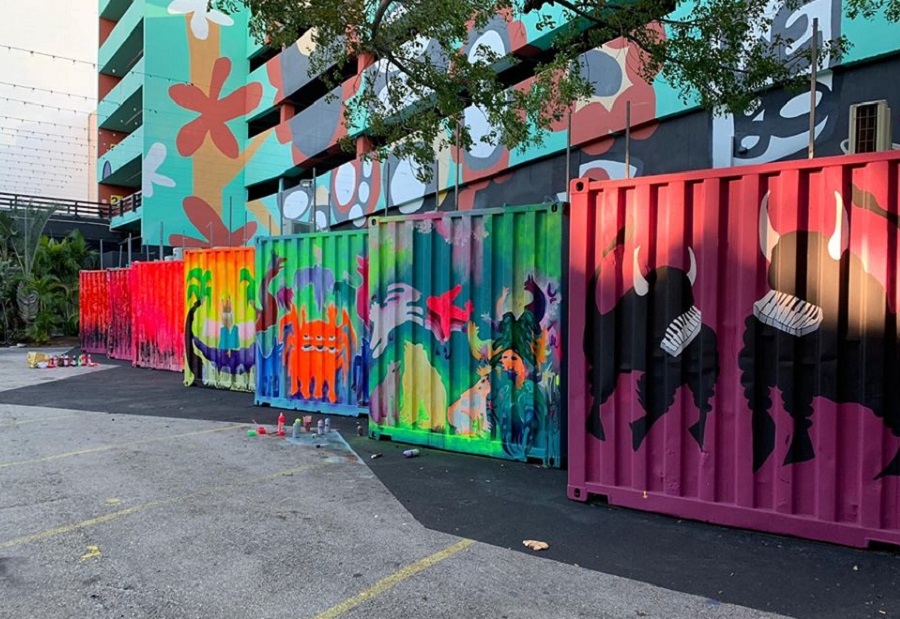Inside seven shipping containers nestled on Miami’s Biscayne Blvd., the nonfiction narratives of Florida natives are currently unspooling in I am Miami (Feb. 14-March 17). From the Kendall to the Allapattah neighborhoods, Spanish playwright and director Lucía Miranda has woven the memories and livelihoods of locals into a multi-part miniseries, for audiences to sample at will. Sundry backgrounds are explored, and diversity celebrated, with true tales of throbbing heartache, racism, immigration burdens, and epic love. As candidly human as their anecdotes are authentic, these people are real, and so are their stories.
“There are seven containers, and I grew seven pieces,” Miranda explains. “Each one contains many stories, each 15 minutes long, in every theatre. Each character has something in common—Miami—but each story is different.”
The Centro Cultural Español received a generous grant for the Knight Foundation to bring Miranda from Spain to the States to research, write, and direct this mobile theatre piece at Microtheater Miami. Miranda was provided a hefty list from CCE of notable Miamians from neighborhoods across the Magic City, and she conducted dozens of interviews with sources from every neck of the woods—geographically, culturally, and occupationally. Hotel maids, journalists, artists, entrepreneurs, parents, and grandparents alike had their own bold stories to share. Miranda recorded each interview, but didn’t just base the plays’ text on those recordings—she also based her staging on them.

Sifting through her 40 interviews, riddled with tales of loss, undeniable bonds, and testaments of the human spirit, a clear vision for the piece emerged. She wanted these stories to be shared by the actors exactly how they were told in real time. Each performer studied their nonfiction character’s recordings and memorized the pauses, pacing, and vocal nuances.
“They have to breathe when person breathes and laugh when the person laughs,” says Miranda of the show’s verbatim performance style. “The actor needs to embody the character, because the character is a real person.”
Her favorite part of the process, she says, were the interviews themselves, which is why she was so determined to get them right. She was invited into the subjects’ homes, ate their home-cooked meals, and met some of the other people who helped shape them. “I got to be inside the life of many people that are so different than me,” says Miranda. “The work with the actors is good and beautiful, but all the knowledge that I got are from the interviews.”
The next step was staging. As its name suggests, Microtheater Miami does all its work in those beached shipping containers: tiny, 160-square-foot, 15-seat spaces. Miranda had to find a way to tell the compelling stories she gathered across seven different stages, and figure out how to tie them together.
“The hardest part has been the containers,” Miranda admits. “I am used to big theatres. I had to put the life of people into 15 minutes, in seven different places. It’s very hard.”
Though each narrative is dynamically individualized, Miranda says she was able to find common threadlines, and to sort the stories into spaces based on these underlying themes. Each container, housing two to three actors, represented one theme: race, sexual identity, relationships, livelihoods, and so on.
Miranda architected this body of work to be relatable for audience members. This, she says, was not difficult.
“It’s all about diversity, and I think these stories talk about the audience,” she explains. “They are going to discover many neighborhoods in Miami, and they will see themselves there. Even in their own neighborhoods, they don’t know the stories inside of other people.”
The plays, performed in both Spanish and English, take place simultaneously every half hour about eight times a night. This gives audiences a chance to catch them in one evening, in any order they want, and to keep coming back for more.
“These stories can be similar to the audience’s own, or remind them of others,” says Miranda. “Some people who are actually related to these characters don’t even know their family member’s full story. It’s so engaging, and everyone will be touched.”


